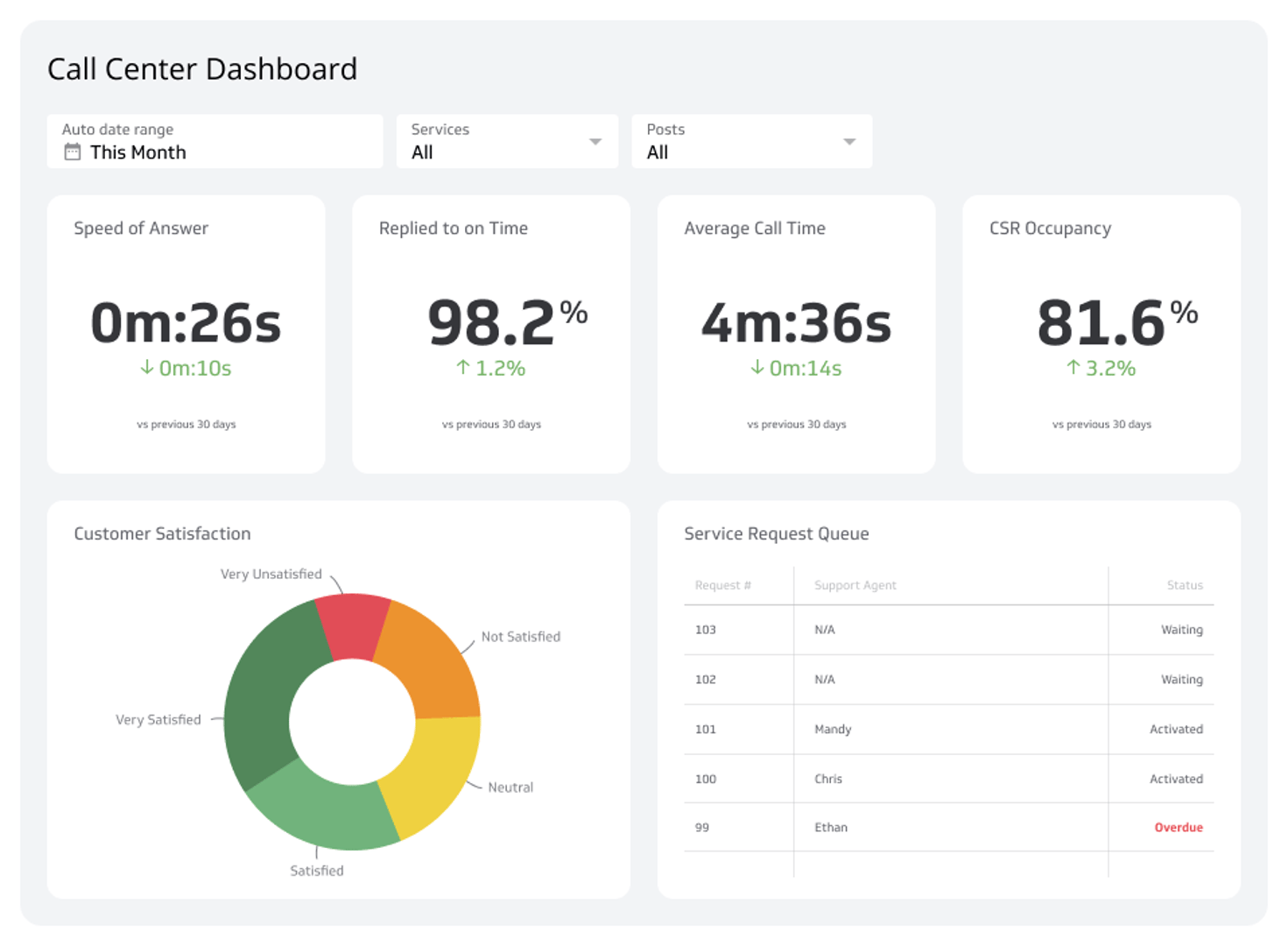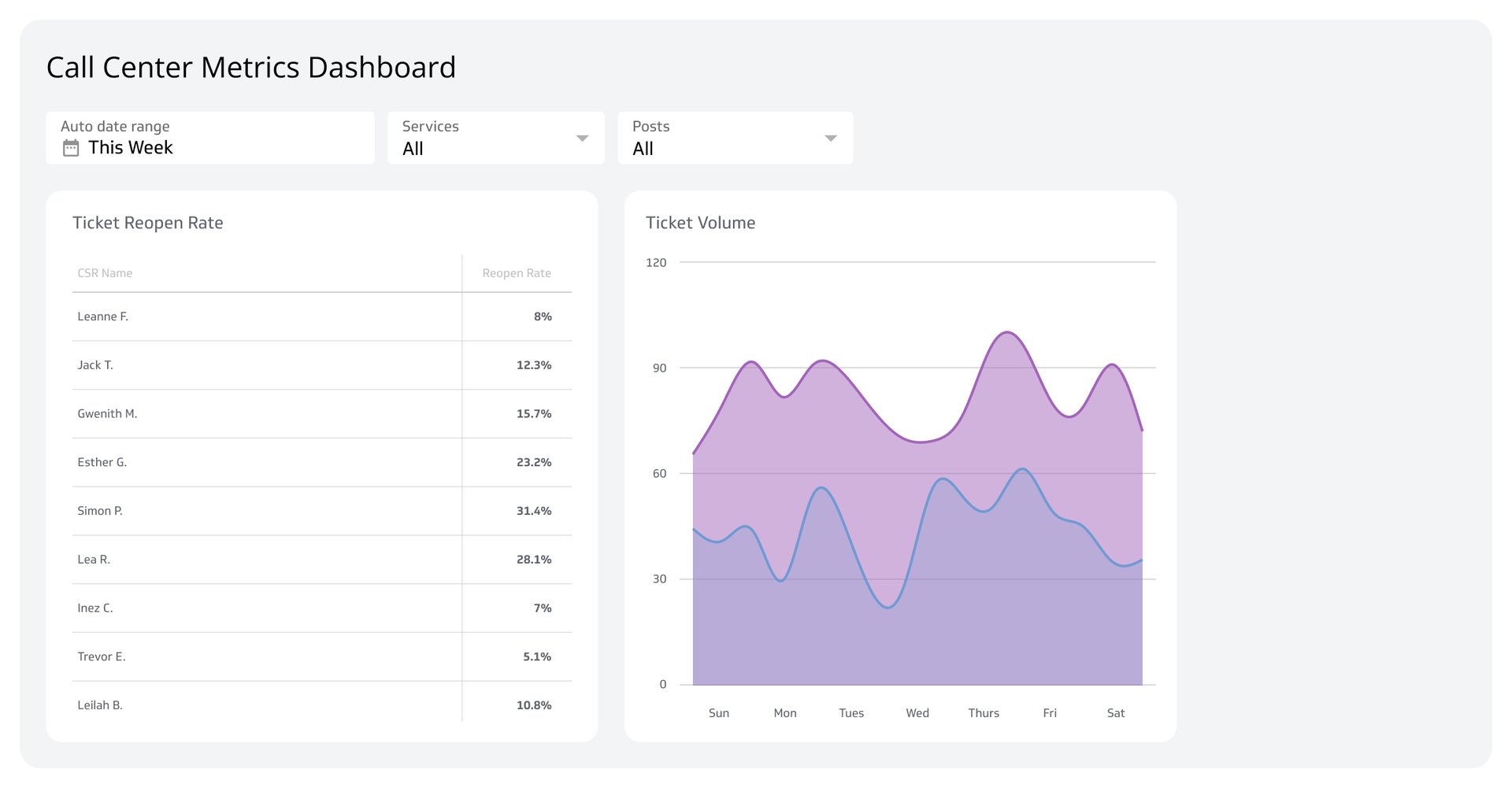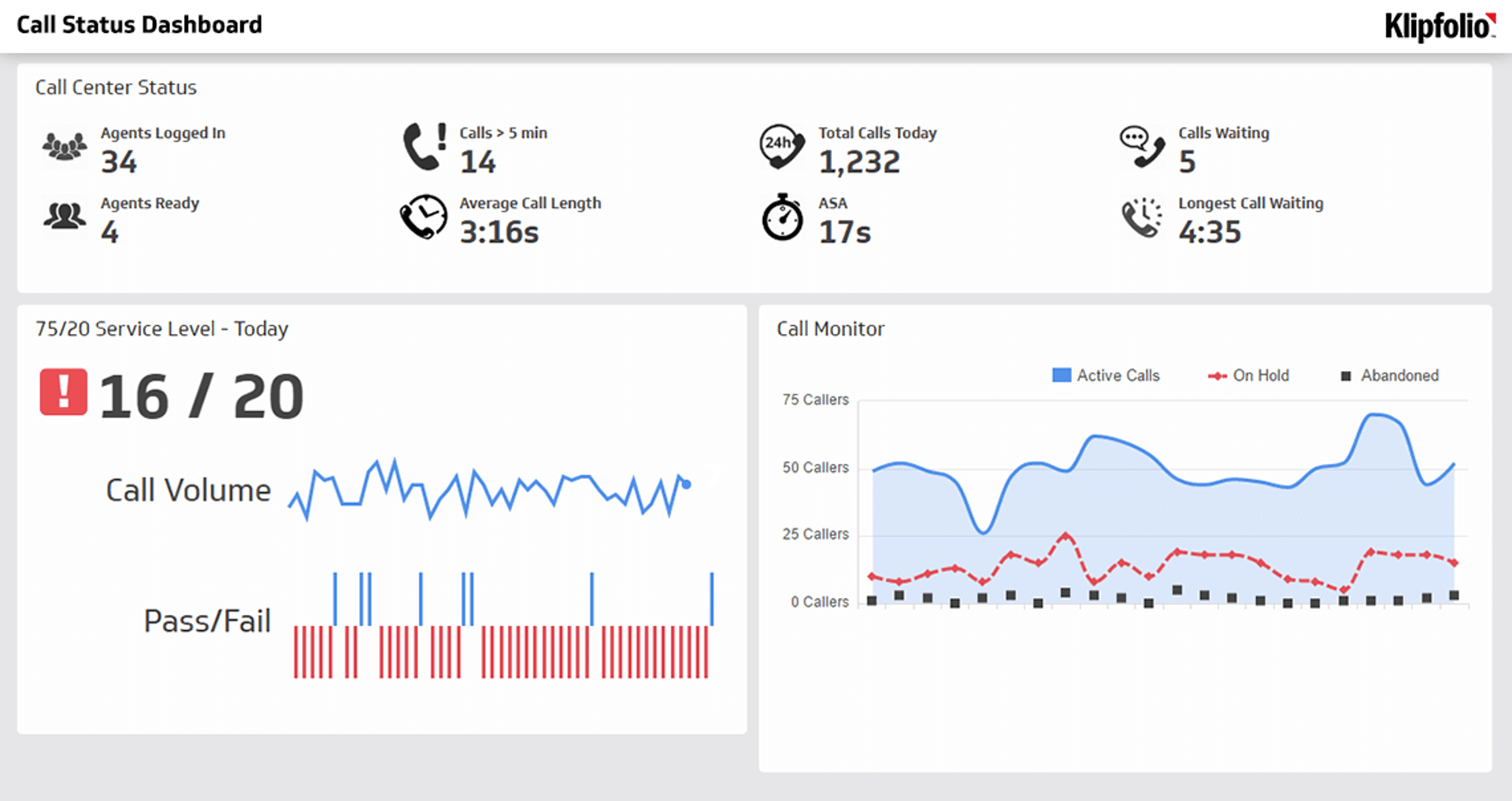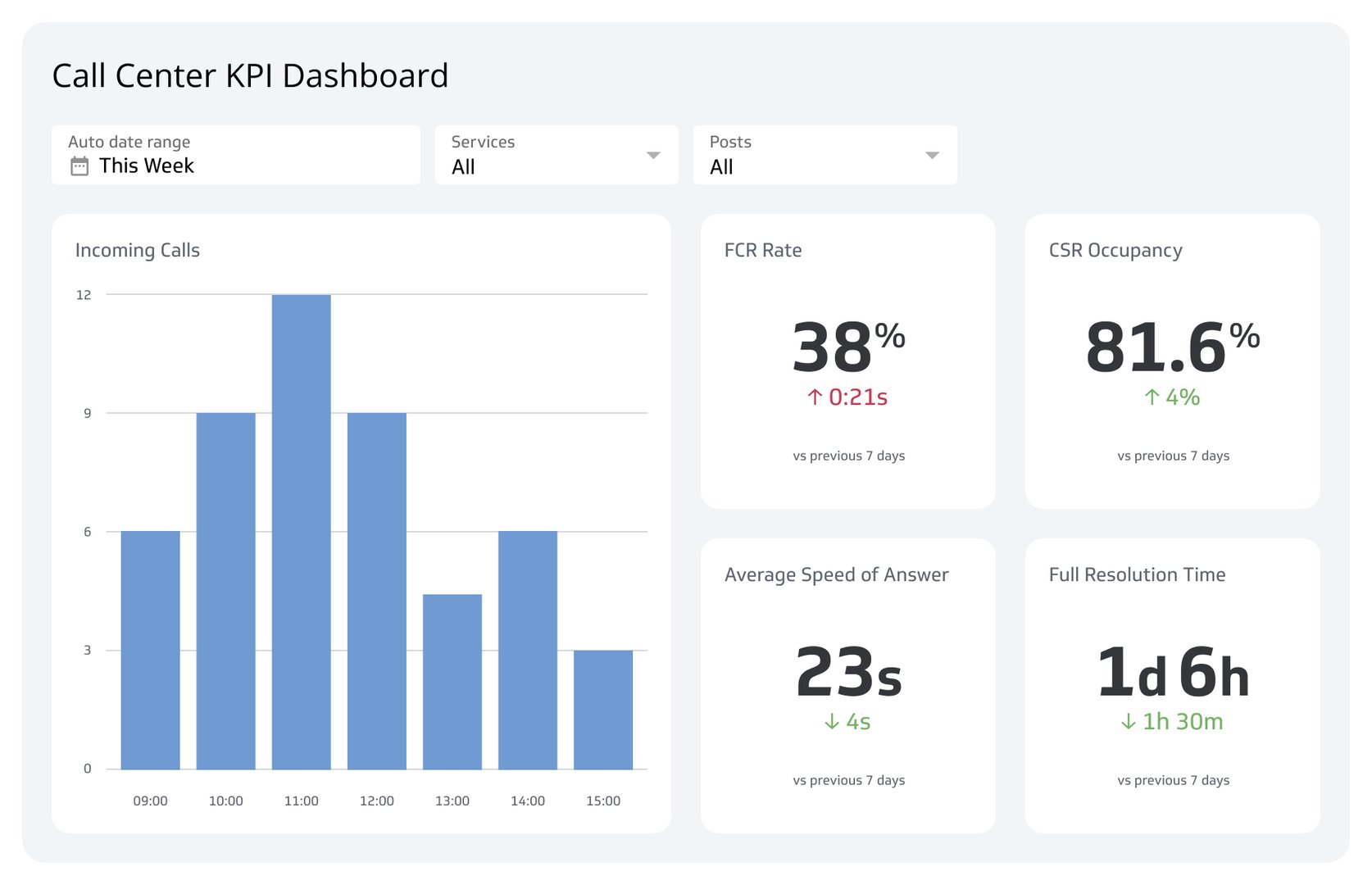Call Center Dashboards
Call center dashboards display key metrics to help you observe and optimize your call center performance and customer service efficiency.
What is a Call Center Dashboard?
A call center dashboard is a tool that displays real-time data specific to call center operations. For example, it can track important call center manager KPIs such as average handle time and first call resolution to let you know how your individual agents and entire customer service teams are performing. It can also display operational metrics like current call volumes and average wait times to help manage your call center’s workload.
In addition, call center dashboards can highlight trends and patterns in customer inquiries, such as frequent complaints, enabling you to address problems proactively. Some of them even provide visual alerts for critical issues, ensuring you can respond to them immediately.
Call Center Dashboard Examples
View all dashboard examplesExamples of Call Center Dashboards
Customer Satisfaction Dashboard
Customer satisfaction dashboards visualize feedback from customers about their service experiences. Metrics they track include net promoter scores, customer satisfaction scores, customer effort scores, and first-call resolution rates.
These dashboards are instrumental in helping you identify patterns and trends in customer feedback, such as recurring issues, common compliments, and areas needing improvement. Moreover, their data can assist you in prioritizing resource allocation based on customer feedback trends.
Who’s it for | Call center managers, quality assurance teams, customer service representatives, team leaders, supervisors, training coordinators, business analysts, technical support teams, senior management, and reporting analysts |
How often it's needed | Real-time, daily, weekly, monthly |
Covered KPIs | Net promoter score (NPS), customer feedback trends, overall satisfaction ratings, First Call Resolution (FCR) rate, call resolution time, customer effort score, agent satisfaction ratings, customer retention rate, call escalation rate, repeat call rate, time to resolve complaints, service level adherence, call monitoring and quality scores, customer sentiment analysis, response time to feedback, percentage of positive/neutral/negative feedback, customer churn rate, resolution accuracy score, agent training effectiveness, customer loyalty index, interaction effectiveness, survey response rates, customer lifetime value (CLV), support ticket satisfaction, interaction channel efficiency, on-hold time |
Call Escalation Dashboard
A call escalation dashboard monitors and tracks instances where calls are escalated to higher levels of support and management. It provides live data on the reasons for escalations, the number of escalations, and the time needed for your customer support to resolve them.
Using this dashboard, you can identify patterns and frequent issues that require escalation and then make appropriate adjustments.
Who’s it for | Call center managers, customer service representatives, team leaders, supervisors, quality assurance teams, training coordinators, technical support teams, business analysts, reporting analysts, senior management |
How often it's needed | Real-time, daily, weekly, monthly |
Covered KPIs | Escalation rate, timeliness of issue resolution, FCR rate, agent escalation frequency, escalation outcome success rate, customer satisfaction post-escalation, escalation reason analysis, average handling time for escalations, tier-level escalation metrics, repeat escalation rate, resolution accuracy, customer effort score, agent performance in managing escalations, volume of escalations per team or department, escalation queue time, training effectiveness for escalation handling, escalation prediction score, adherence to escalation protocols, IT and system issues contributing to escalations, feedback from escalated calls, overall impact of escalations on service level agreements (SLAs), cost per escalation, impact of escalations on customer retention, and escalation reduction initiatives success rate |
Helpdesk Dashboard
Helpdesk dashboards showcase data related to support ticket management and resolution. A well-built example will provide real-time information on the number of open, pending, and resolved tickets and metrics/KPIs, such as average resolution time and CSAT scores.
Applying a helpdesk dashboard can improve your effectiveness at prioritizing agent tasks and identifying issues like system glitches, common customer complaints, and frequent questions.
Who’s it for | Call center managers, team leaders, supervisors, customer service representatives, quality assurance teams, technical support teams, training coordinators, business analysts, reporting analysts, senior management. |
How often it's needed | Real-time, daily, weekly, monthly |
Covered KPIs | Ticket resolution time, first response time, customer satisfaction score (CSAT), FCR rate, ticket backlog, average handle time (AHT), agent productivity metrics, ticket reopen rate, escalation rate, service level agreement (SLA) adherence, number of tickets by category, volume of tickets by channel (phone, email, chat), agent utilization rate, ticket aging, resolution accuracy, customer effort score (CES), agent training effectiveness, number of escalated tickets, feedback from resolved tickets, cost per ticket, impact of helpdesk on customer retention, automation effectiveness, ticket prioritization accuracy, team workload balance, and incident and problem management efficiency |
Agent Performance Dashboard
Agent performance dashboards let you observe metrics behind individual and team productivity. For example, they display real-time data on handling times and the daily number of calls each agent answers. They also show KPIs like first-call resolution rates and CSAT scores, which tell how happy customers are with the service they receive.
This dashboard can be used to track and evaluate agent performance more effectively. For instance, if an agent consistently has longer call handling times, the dashboard can help identify whether they need additional training.
Who’s it for | Call center managers, supervisors, team leaders, customer service representatives, technical support teams, quality assurance teams, training coordinators, business analysts, reporting analysts, senior management |
How often it's needed | Real-time, daily, weekly, monthly |
Covered KPIs | AHT, FCR rate, CSAT score, call volume, call transfer rate, adherence to schedule, after-call work time, SLA compliance, call quality score, agent occupancy rate, agent availability, hold time per call, call abandonment rate, escalation rate, average speed of answer (ASA), agent attendance, ticket resolution time, call center shrinkage, agent turnover rate, coaching effectiveness score, agent utilization rate, training completion rates, peer feedback, customer feedback comments, performance scorecards, cross-selling and upselling success rates, agent engagement metrics, and overall contribution to team goals |
Customer Retention Dashboard
Customer retention dashboards act as meters that let you measure customer loyalty and retention. They supply data on retention rates, which show the percentage of customers who remain with the company over a specific period. These dashboards also track churn rates, which indicate how many customers are leaving, and assess the effectiveness of retention initiatives.
A customer retention dashboard’s data helps you identify early signs of customer dissatisfaction, such as increased churn rates or declining engagement. More importantly, this data can point out when you should initiate follow-up calls or enhance loyalty programs to improve retention.
Who’s it for | Call center managers, technical support teams, supervisors, senior management, customer service representatives, team leaders, reporting analysts, business analysts, training coordinators, quality assurance teams |
How often it's needed | Real-time, daily, weekly, monthly |
Covered KPIs | Customer churn rate, CLV, repeat call ratio, FCR rate, CSAT score, NPS, AHT, retention rate by customer segment, follow-up call rates, win-back rates, SLA compliance, agent performance impact on retention, cost per retained customer, customer feedback comments, loyalty program participation rates, account issue resolution time, escalation rate, customer complaint resolution rate, proactive service interaction rate, customer tenure length, retention campaign effectiveness, impact of retention training programs, customer communication preferences, agent training completion rates, customer exit survey scores, and overall customer happiness index |
Call Volume Analysis Dashboard
Call volume analysis dashboards are designed to track and scrutinize the number of calls made and received across various timeframes. Such dashboards present information regarding peak call periods, average call durations, and fluctuations in call volume, which help you know where resources should be best allocated.
In addition, call volume analysis dashboards uncover patterns in all traffic, such as seasonal increases or sudden spikes that may signify underlying issues or promotions. Understanding these patterns enables you to plan ahead more effectively and make sure you have the right number of agents available at the correct times.
Who’s it for | Call center managers, supervisors, team leaders, workforce management teams, reporting analysts, business analysts, senior management, technical support teams, quality assurance teams |
How often it's needed | Real-time, daily, weekly, monthly |
Covered KPIs | Total call volume, peak hour traffic, dial per hour, call distribution by day of the week, service level, average wait time, call abandonment rate, average handle time, average speed of answer, call queue length, call distribution by agent, call transfer rate, first call resolution rate, repeat call rate, call duration trends, inbound vs. outbound call ratios, call variance compared to forecast, agent occupancy rate, adherence to scheduling, call center traffic patterns, customer satisfaction scores, call source analysis, percentage of calls handled by interactive voice response (IVR) systems, call drop rate, call quality scores, agent workload distribution, and impact of marketing campaigns on call volume |
Call Quality Monitoring Dashboard
A call quality monitoring dashboard evaluates and displays metrics related to the quality of customer interactions, such as call resolution rates, customer satisfaction scores, call quality scores, and adherence to call scripts or protocols. This dashboard lets you identify and address call quality issues, such as long hold times or poor communication skills, which can negatively impact the customer experience.
Who’s it for | Call center managers, supervisors, team leaders, quality assurance teams, training and development specialists, senior management, customer experience managers, reporting analysts |
How often it's needed | Real-time, daily, weekly, monthly |
Covered KPIs | Call quality scores, customer satisfaction ratings, first call resolution rates, average handle time, call compliance scores, agent performance scores, call monitoring frequency, call sentiment analysis, customer feedback and comments, issue resolution times, agent adherence to scripts, call escalation rates, training needs identification, call recording and review frequency, customer effort scores, call outcome analysis, agent coaching effectiveness, quality assurance pass rates, root cause of call escalations, customer churn rate linked to call quality, call auditing results, agent empathy scores, compliance with regulatory standards, post-call survey results, customer complaint trends, and overall service quality index |
First-Call Resolution Dashboard
First-call resolution dashboards measure how effectively customer issues are resolved during the first call. With them, you can gain insight into FCR rates and determine the percentage of customer inquiries or problems addressed satisfactorily without needing follow-up calls or escalations.
The data from a first-call resolution dashboard helps you recognize early signs of inefficiency in issue resolution, such as declining FCR rates or increasing repeat call ratios. Furthermore, this data can signal when to implement training sessions or refine procedures to boost the efficacy of issue resolution on the first contact.
Who’s it for | Call center managers, technical support teams, supervisors, senior management, customer service representatives, team leaders, reporting analysts, business analysts, training coordinators, quality assurance teams |
How often it's needed | Real-time, daily, weekly, monthly |
Covered KPIs | FCR rate, repeat call ratio, issue resolution time, call transfer rates, CSAT score, NPS, AHT, escalation rate, agent performance impact on FCR, cost per resolved issue, customer feedback comments, training program effectiveness, SLA compliance, proactive service interaction rate, customer engagement metrics, customer complaint resolution rate, agent training completion rates, root cause analysis of unresolved issues, customer issue complexity, first contact resolution ratio by customer segment, time-saving techniques effectiveness, customer exit survey scores, overall efficiency index |
Agent Utilization Dashboard
An agent utilization dashboard offers deep insights into agent occupancy rates, which reflect the percentage of an agent’s working time dedicated to managing customer interactions. It typically shows metrics like agent occupancy rates, call handling times, and the distribution of workload.
By regularly checking on this dashboard, you can spot early signs of inefficiencies, such as prolonged idle times or extended call handling durations. This information is essential for formulating data-driven decisions on workforce scheduling adjustments to improve agent productivity and service quality.
Who’s it for | Call center managers, technical support teams, supervisors, senior management, customer service representatives, team leaders, reporting analysts, business analysts, training coordinators, quality assurance teams |
How often it's needed | Real-time, daily, weekly, monthly |
Covered KPIs | Agent occupancy rate, idle time, AHT, number of calls handled per agent, call transfer rates, CSAT score, NPS, adherence to schedule, after-call work time, agent performance scores, workload balance, SLA compliance, agent satisfaction rates, training program effectiveness, break adherence, call resolution time, ASA, agent absenteeism rate, customer feedback comments, call abandonment rate, agent interaction quality score, workforce scheduling efficiency, agent engagement metrics, overtime hours, overall efficiency index |
Call center data made accessible
Call center dashboards automate the data-acquisition process and display metrics critical to the call center industry in charts, graphs, and tables. These dashboards prioritize live information, too, so they’re always up-to-date. Check them regularly and obtain the insights you need to take immediate action.
Klipfolio has all the customizable dashboards you need to track your call center’s metrics and KPIs. Try it out today!




